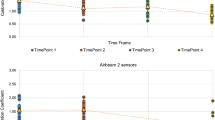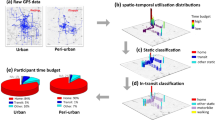Abstract
Personal nephelometers provide useful real-time measurements of airborne particulate matter (PM). Recent studies have applied this tool to assess personal exposures and related health effects. However, a thorough quality control (QC) procedure for data collected from such a device in a large-scale exposure assessment study is lacking. We have evaluated the performance of a personal nephelometer (personal DataRAM or pDR) in the field. We present here a series of post hoc QC procedures for improving the quality of the pDR data. The correlations and the ratios between the pDRs and the collocated gravimetric measurements were used as indices of the pDR data quality. The pDR was operated in four modes: passive (no pump), active (with personal sampling pumps), active with a heated inlet, and a humidistat. The pDRs were worn by 21 asthmatic children, placed at their residences indoors and outdoors, as well as at a central site. All fixed-site pDRs were collocated with Harvard Impactors for PM2.5 (HI2.5). By examining the differences between the time-weighted average concentrations calculated from the real-time pDRs’ readings and recorded internally by the pDRs, we identified 9.1% of the pDRs’ measurements suffered from negative drifts. By comparing the pDRs’ daily base level with the HI2.5 measurements, we identified 5.7% of the pDRs’ measurements suffered from positive drifts. High relative humidity (RH) affected outdoor pDR measurements, even when a heater was used. Results from a series of chamber experiments suggest that the heated air stream cooled significantly after leaving the heater and entering the pDR light-scattering chamber. An RH correction equation was applied to the pDR measurements to remove the RH effect. The final R2 values between the fixed-site pDRs and the collocated HI2.5 measurements ranged between 0.53 and 0.72. We concluded that with a carefully developed QC procedure, personal nephelometers can provide high-quality data for assessing PM exposures on subjects and at fixed locations. We also recommend that outdoor pDRs be operated in the active mode without a heater and that the RH effect be corrected with an RH correction equation.
This is a preview of subscription content, access via your institution
Access options
Subscribe to this journal
Receive 6 print issues and online access
$259.00 per year
only $43.17 per issue
Buy this article
- Purchase on Springer Link
- Instant access to full article PDF
Prices may be subject to local taxes which are calculated during checkout






Similar content being viewed by others
References
Ames R.B., Hand J.L., Kreidenweis S.M., Day D.E., and Malm W.C. Optical measurements of aerosol size distributions in Great Smoky Mountains National Park: dry aerosol characterization. J Air Waste Manage Assoc 2000: 50(5): 665–676.
Babich P., Davey M., Allen G., and Koutrakis P. Method comparisons for particulate nitrate, elemental carbon, and PM2.5 mass in seven US cities. J Air Waste Manage Assoc 2000: 50(7): 1095–1105.
Balakrishnan K., Parikh J., Sankar S., Padmavathi R., Srividya K., Venugopal V., and Prasad S., et al. Daily average exposures to respirable particulate matter from combustion of biomass fuels in rural households of southern India. Environ Health Perspect 2002: 110(11): 1069–1075.
Bergin M.H., Ogren J.A., Schwartz S.E., and McInnes L.M. Evaporation of ammonium nitrate aerosol in a heated nephelometer: Implications for field measurements. Environ Sci Technol 1997: 31(10): 2878–2883.
Brauer M. Assessment of indoor aerosols with an integrating nephelometer. J Expos Anal Environ Epidemiol 1995: 5(1): 45–56.
Day D.E., and Malm W.C. Aerosol light scattering measurements as a function of relative humidity: a comparison between measurements made at three different sites. Atmos Environ 2001: 35(30): 5169–5176.
Day D.E., Malm W.C., and Kreidenweis S.M. Aerosol light scattering measurements as a function of relative humidity. J Air Waste Manage Assoc 2000: 50(5): 710–716.
EPA US. National Air Quality and Emissions Trends Report. Office of Air Quality Planning and Standards, 1999.
EPA US. Fourth External Review Draft of Air Quality Criteria for Particulate Matter. Office of Research and Development, 2003.
Howard-Reed C., Rea A.W., Zufall M.J., Burke J.M., Williams R.W., Suggs J.C., and Sheldon L.S., et al. Use of a continuous nephelometer to measure personal exposure to particles during the US Environmental Protection Agency Baltimore and Fresno panel studies. J Air Waste Manage Assoc 2000: 50(7): 1125–1132.
Lanki T., Alm S., Ruuskanen J., Janssen N.A.H., Jantunen M., and Pekkanen J. Photometrically measured continuous personal PM2.5 exposure: levels and correlation to a gravimetric method. J Expos Anal Environ Epidemiol 2002: 12(3): 172–178.
Liu L.J.S., Box M., Kalman D., Kaufman J., Koenig J., Larson T., and Lumley T., et al. Exposure assessment of particulate matter for susceptible populations in Seattle. Environ Health Perspect 2003: 111(7): 909–918.
Liu L.J.S., Slaughter J.C., and Larson T.V. Comparison of light scattering devices and impactors for particulate measurements in indoor, outdoor, and personal environments. Environ Sci Technol 2002: 36(13): 2977–2986.
Lowenthal D.H., Rodgers C.F., Saxena P., Watson J.G., and Chow J.C. Sensitivity of estimated light extinction coefficients to model assumptions and measurement errors. Atmos Environ 1995: 29(7): 751–766.
McMurry P.H., and Stolzenburg M.R. On the sensitivity of particle-size to relative-humidity for Los-Angeles aerosols. Atmos Environ 1989: 23(2): 497–507.
MIE. Application Note 10-B. Monitoring with DataRAM in wet/high humidity environments. MIE, Inc., 1994.
Muraleedharan T.R., and Radojevic M. Personal particle exposure monitoring using nephelometry during haze in Brunei. Atmos Environ 2000: 34(17): 2733–2738.
O'Neil M.J., (ed.). The Merck index: An Encyclopedia of Chemicals, Drugs, and Biologicals. Merck & Co., Inc., Rahway, 2001.
Quintana P.J.E., Samimi B.S., Kleinman M.T., Liu L.J., Soto K., Warner G.Y., and Bufalino C., et al. Evaluation of a real-time passive personal particle monitor in fixed site residential indoor and ambient measurements. J Expos Anal Environ Epidemiol 2000: 10(5): 437–445.
Quintana P.J.E., Valenzia J.R., Delfino R.J., and Liu L.J.S. Monitoring of 1-min personal particulate matter exposures in relation to voice-recorded time-activity data. Environ Res 2001: 87(3): 199–213.
Rea A.W., Zufall M.J., Williams R.W., Sheldon L., and Howard-Reed C. The influence of human activity patterns on personal PM exposure: A comparative analysis of filter-based and continuous particle measurements. J Air Waste Manage Assoc 2001: 51(9): 1271–1279.
Richards L.W., Alcorn S.H., McDade C., Couture T., Lowenthal D., Chow J.C., and Watson J.G. Optical properties of the San Joaquin Valley aerosol collected during the 1995 integrated monitoring study. Atmos Environ 1999: 33(29): 4787–4795.
Shumway R.H. Applied Statistical Time Series Analysis. Prentice-Hall, Englewood cliffs, NJ, 1988.
Sioutas C., Kim S., Chang M.C., Terrell L.L., and Gong H. Field evaluation of a modified DataRAM MIE scattering monitor for real-time PM2.5 mass concentration measurements. Atmos Environ 2000: 34(28): 4829–4838.
Sloane C.S. Optical-properties of aerosols of mixed composition. Atmos Environ 1984: 18(4): 871–878.
Sloane C.S., and Wolff G.T. Prediction of ambient light-scattering using a physical model responsive to relative-humidity — validation with measurements from Detroit. Atmos Environ 1985: 19(4): 669–680.
Thomas A., and Gebhart J. Correlations between gravimetry and light-scattering photometry for atmospheric aerosols. Atmos Environ 1994: 28(5): 935–938.
Wallace L.A., Herman M., O'Connor G.T., Lucas N., Morton L., Meyer K., and Jane K., et al. Particle concentrations in inner-city homes of children with asthma: The effect of smoking, cooking, and outdoor pollution. Environ Health Perspect 2003: 111(9): 1265–1272.
Williams R., Suggs J., Zweidinger R., Evans G., Creason J., Kwok R., and Rodes C., et al. The 1998 Baltimore particulate matter epidemiology-exposure study: Part 1. comparison of ambient, residential outdoor, indoor and apartment particulate matter monitoring. J Expos Anal Environ Epidemiol 2000: 10(6): 518–532.
Acknowledgements
This study was funded by the NIH/NIEHS Grant ES-06214 and EPA Northwest Research Center for Particulate Air Pollution and Health Grant R827355. We also thank Dr. Timothy Larson for his insightful comments.
Author information
Authors and Affiliations
Corresponding author
Rights and permissions
About this article
Cite this article
Wu, CF., Delfino, R., Floro, J. et al. Evaluation and quality control of personal nephelometers in indoor, outdoor and personal environments. J Expo Sci Environ Epidemiol 15, 99–110 (2005). https://doi.org/10.1038/sj.jea.7500351
Received:
Accepted:
Published:
Issue Date:
DOI: https://doi.org/10.1038/sj.jea.7500351
Keywords
This article is cited by
-
Examining the representativeness of home outdoor PM2.5, EC, and OC estimates for daily personal exposures in Southern California
Air Quality, Atmosphere & Health (2012)
-
Validation of continuous particle monitors for personal, indoor, and outdoor exposures
Journal of Exposure Science & Environmental Epidemiology (2011)
-
Infiltration of forest fire and residential wood smoke: an evaluation of air cleaner effectiveness
Journal of Exposure Science & Environmental Epidemiology (2008)
-
Measurement of particle concentrations in a dental office
Environmental Monitoring and Assessment (2008)
-
Field performance of a nephelometer in rural kitchens: effects of high humidity excursions and correlations to gravimetric analyses
Journal of Exposure Science & Environmental Epidemiology (2007)



